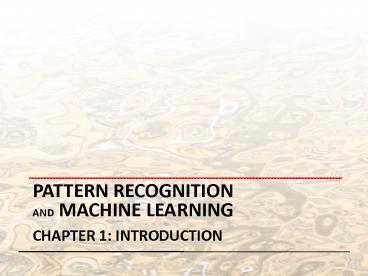Pattern Recognition and Machine Learning - PowerPoint PPT Presentation
1 / 49
Title:
Pattern Recognition and Machine Learning
Description:
... an example ... Bayesian Linear Regression (3) 0 data points observed ... Predict t for new values of x by integrating over w: where. Predictive Distribution (2) ... – PowerPoint PPT presentation
Number of Views:40
Avg rating:3.0/5.0
Title: Pattern Recognition and Machine Learning
1
Pattern Recognition and Machine Learning
Chapter 1 Introduction
2
Expectations
3
Expectations
Conditional Expectation (discrete)
Approximate Expectation (discrete and continuous)
4
Variances and Covariances
5
Intinsic Error
- PRML 1.5.5
6
Curve Fitting Re-visited
7
Maximum Likelihood
Determine by minimizing sum-of-squares
error, .
8
Minimizing the loss function for regression
- Using the squared error as the loss function
- We want to choose y(x) to minimize the expected
loss
9
- Solving for y(x), we get
10
The Squared Loss Function
11
- The first term is minimized when we select y(x)
as - The second term is independent of y(x) and
represents the intrinsic variability of the
target - It is called the intrinsic error.
12
(No Transcript)
13
Inverse Problems
14
Bias, Variance
- PRML 3.2
15
The Bias-Variance Decomposition (1)
- Recall the expected squared loss,
- where
- The second term corresponds to the noise inherent
in the random variable t. - What about the first term?
16
The Bias-Variance Decomposition (2)
- Suppose we were given multiple data sets, each of
size N. Any particular data set, D, will give a
particular function y(x D). We then have
17
The Bias-Variance Decomposition (3)
- Taking the expectation over D yields
18
The Bias-Variance Decomposition (4)
- Thus we can write
- where
19
- Bias measures how much the prediction (averaged
over all data sets) differs from the desired
regression function. - Variance measures how much the predictions for
individual data sets vary around their average. - There is a trade-off between bias and variance
- As we increase model complexity,
- bias decreases (a better fit to data) and
- variance increases (fit varies more with data)
20
f
f
bias
gi
g
variance
21
Reminder Introduction to OverfittingPRML 1.1
- Concepts Polynomial curve fitting,
- overfitting, regularization,
- training set size vs model complexity
22
Polynomial Curve Fitting
23
Sum-of-Squares Error Function
24
0th Order Polynomial
25
1st Order Polynomial
26
3rd Order Polynomial
27
9th Order Polynomial
28
Over-fitting
Root-Mean-Square (RMS) Error
29
Polynomial Coefficients
30
Regularization
- Penalize large coefficient values
31
Regularization
32
Regularization
33
Regularization vs.
34
Polynomial Coefficients
35
Back to Bias/Variance
36
The Bias-Variance Decomposition (5)
- Example 100 data sets, each with 25 data points
from the sinusoidal h(x) sin(2px), varying the
degree of regularization, l.
37
The Bias-Variance Decomposition (6)
- Example 100 data sets, each with 25 data points
from the sinusoidal h(x) sin(2px), varying the
degree of regularization, l.
38
The Bias-Variance Decomposition (7)
- Example 100 data sets, each with 25 data points
from the sinusoidal h(x) sin(2px), varying the
degree of regularization, l.
39
The Bias-Variance Trade-off
- From these plots, we note that an
over-regularized model (large l) will have a high
bias, while an under-regularized model (small l)
will have a high variance.
Minimum value of bias2variance is around
l-0.31 This is close to the value that gives the
minimum error on the test data.
40
f
f
bias
gi
g
variance
41
Model Selection Procedures
- Regularization (Breiman 1998) Penalize the
augmented error - error on data l.model complexity
- If l is too large, we risk introducing bias
- Use cross validation to optimize for l
- Structural Risk Minimization (Vapnik 1995)
- Use a set of models ordered in terms of their
complexities - Number of free parameters
- VC dimension,
- Find the best model w.r.t empirical error and
model complexity. - Minimum Description Length Principle
- Bayesian Model Selection If we have some prior
knowledge about the approximating function, it
can be incorporated into the Bayesian approach in
the form of p(model).
42
Bayesian Model Selection
- Prior on models, p(model)
- When prior favors simpler models Bayesian,
regularization, SRM and MDL are equivalent.
43
Model Selection Procedures
- Cross validation Measure the total error, rather
than bias/variance, on a validation set. - Train/Validation sets
- K-fold cross validation
- Leave-One-Out
- No prior assumption about the models
44
Polynomial Regression
Best fit min error
45
Best fit, elbow
46
- Averaging of multiple solutions which themselves
have low bias - Lower variance due to averaging
- Ensembles, mixture of experts, committee
machines - Bayesian approach weighted average
- Increasing the number of data points N
- Constrains the solutions, reducing variance
47
Data Set Size
9th Order Polynomial
48
Data Set Size
9th Order Polynomial
49
End of Lecture Skip the Rest
50
Bayesian Linear Regression (1)
- Define a conjugate prior over w
- Combining this with the likelihood function and
using results for marginal and conditional
Gaussian distributions, gives the posterior - where
51
Bayesian Linear Regression (2)
- For simplicity, lets assume that the prior is
- for which
- Next we consider an example
52
Bayesian Linear Regression (3)
0 data points observed
Prior
Data Space
53
Bayesian Linear Regression (4)
1 data point observed
Likelihood
Posterior
Data Space
54
Bayesian Linear Regression (5)
2 data points observed
Likelihood
Posterior
Data Space
55
Bayesian Linear Regression (6)
20 data points observed
Likelihood
Posterior
Data Space
56
Predictive Distribution (1)
- Predict t for new values of x by integrating over
w - where
57
Predictive Distribution (2)
- Example Sinusoidal data, 9 Gaussian basis
functions, 1 data point
58
Predictive Distribution (3)
- Example Sinusoidal data, 9 Gaussian basis
functions, 2 data points
59
Predictive Distribution (4)
- Example Sinusoidal data, 9 Gaussian basis
functions, 4 data points
60
Predictive Distribution (5)
- Example Sinusoidal data, 9 Gaussian basis
functions, 25 data points































